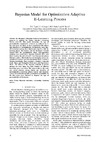Identificador persistente para citar o vincular este elemento:
https://accedacris.ulpgc.es/jspui/handle/10553/73956
| Campo DC | Valor | idioma |
|---|---|---|
| dc.contributor.author | Tapia, Francisco | en_US |
| dc.contributor.author | Lopez, C. A. | en_US |
| dc.contributor.author | Galan, M. J. | en_US |
| dc.contributor.author | Rubio Royo, Enrique | en_US |
| dc.date.accessioned | 2020-08-05T09:12:32Z | - |
| dc.date.available | 2020-08-05T09:12:32Z | - |
| dc.date.issued | 2008 | en_US |
| dc.identifier.issn | 1868-8799 | en_US |
| dc.identifier.other | Scopus | - |
| dc.identifier.other | WoS | - |
| dc.identifier.uri | https://accedacris.ulpgc.es/handle/10553/73956 | - |
| dc.description.abstract | In this paper, a Bayesian-Network-based model is proposed to optimize the Global Adaptive e-Learning Process (GAeLP). This model determines the type of personalization required for a learner according to his or her real needs, in which we have considered both objects and objectives of personalization. Furthermore, cause-andeffect relations among these objects and objectives with the learning phases, the learner, and the Intelligent Tutorial System (ITS) are accomplished. These cause-and-effect relations were coded into a Bayesian Network (BN), such that it involves the entire GAeLP. Four fundamental phases that have a direct effect in the learner's learning process are considered: Learner's previous knowledge Phase, Learner's Progress Knowledge Phase, Learner's /Teacher's Aims and Goals Phase, and Navigation Preferences and Experiences Phase. The efficacy of the Bayesian networks is proven through the first phase, in which learners of different knowledge area were select. The main results in this work are: causal relations among objects and objectives of personalization, knowledge phases, learner and electronic system. Personalization profiles set and their probabilities in the first phase were obtained to diagnose the type of personalization of the learner. | en_US |
| dc.language | eng | en_US |
| dc.relation.ispartof | International Journal of Emerging Technologies in Learning | en_US |
| dc.source | International Journal of Emerging Technologies in Learning [ISSN 1868-8799], v. 3 (2), p. 38-52, (Diciembre 2008) | en_US |
| dc.subject | 33 Ciencias tecnológicas | en_US |
| dc.subject.other | Bayesian Networks | en_US |
| dc.subject.other | E-Learning | en_US |
| dc.subject.other | Learning Metrics | en_US |
| dc.title | Bayesian model for optimization adaptive e-learning process | en_US |
| dc.type | info:eu-repo/semantics/Article | en_US |
| dc.type | Article | en_US |
| dc.identifier.scopus | 84862981345 | - |
| dc.identifier.isi | 000215426300006 | - |
| dc.contributor.authorscopusid | 55266091100 | - |
| dc.contributor.authorscopusid | 57212937730 | - |
| dc.contributor.authorscopusid | 15924912300 | - |
| dc.contributor.authorscopusid | 7101626071 | - |
| dc.identifier.eissn | 1863-0383 | - |
| dc.description.lastpage | 52 | en_US |
| dc.identifier.issue | 2 | - |
| dc.description.firstpage | 38 | en_US |
| dc.relation.volume | 3 | en_US |
| dc.investigacion | Ingeniería y Arquitectura | en_US |
| dc.type2 | Artículo | en_US |
| dc.contributor.daisngid | 32087870 | - |
| dc.contributor.daisngid | 12519627 | - |
| dc.contributor.daisngid | 32217737 | - |
| dc.contributor.daisngid | 8386397 | - |
| dc.description.numberofpages | 15 | en_US |
| dc.utils.revision | Sí | en_US |
| dc.contributor.wosstandard | WOS:Tapia, FJ | - |
| dc.contributor.wosstandard | WOS:Lopez, CA | - |
| dc.contributor.wosstandard | WOS:Galan, MJ | - |
| dc.contributor.wosstandard | WOS:Rubio, E | - |
| dc.date.coverdate | Diciembre 2008 | en_US |
| dc.identifier.ulpgc | Sí | es |
| dc.description.esci | ESCI | |
| item.fulltext | Con texto completo | - |
| item.grantfulltext | open | - |
| crisitem.author.dept | GIR IUCTC: Centro de Innovación para la Sociedad de la Información | - |
| crisitem.author.dept | IU de Cibernética, Empresa y Sociedad (IUCES) | - |
| crisitem.author.parentorg | IU de Cibernética, Empresa y Sociedad (IUCES) | - |
| crisitem.author.fullName | Rubio Royo,Enrique | - |
| Colección: | Artículos | |
Citas SCOPUSTM
5
actualizado el 08-jun-2025
Citas de WEB OF SCIENCETM
Citations
3
actualizado el 25-feb-2024
Visitas
89
actualizado el 01-feb-2025
Descargas
102
actualizado el 01-feb-2025
Google ScholarTM
Verifica
Comparte
Exporta metadatos
Los elementos en ULPGC accedaCRIS están protegidos por derechos de autor con todos los derechos reservados, a menos que se indique lo contrario.
